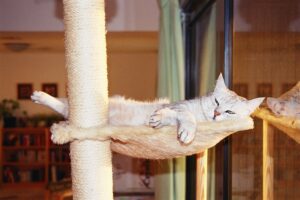Barks Blog
Clicker Training for Cats (3/6)
By Paula Garber and Francine Miller

Cats learn best when they are comfortable and free from distractions. They are sensitive and will flee from any threat or uncertainty (and we don’t work with them on a leash!) The best place to teach a cat is somewhere he finds quiet and familiar. This may be challenging because with their acute senses of smell and hearing they may be distracted by things we are unaware of.
You should train in a place with a litter box available, fresh water and a place to retreat to or rest. Cats do not usually learn well immediately after they have eaten, so just like dogs, they will be more motivated by food reinforcers if they are hungry.
The way you train should be tailored to your individual cat. This means identifying the best reward(s), the optimal length of a training session, how fast your cat learns and the best training aids to use. It can be helpful to establish cues to communicate to the cat when a formal training session begins and ends. Verbal cues such as “let’s train!” and “all done!” typically work well.
Your cat’s personality and readiness to learn must also be considered. How bold or timid is he? Bold cats are more inclined to get involved in situations they have not encountered before, while timid cats hang back, finding unfamiliar objects daunting and potentially threatening. A cat’s readiness to learn is affected by his mood at the time. For example, some cats are generally difficult to motivate and may seem bored while training. Or a cat may be overexcited by training and too focused on the reward rather than the behavior to obtain it.
Finally, it is important to take previous negative experiences into account, especially if you are going to work on changing the cat’s emotional state to a positive one. Training of this sort will take longer and require a slower pace than if no prior negative association had been made.
It is important to note that cats learn fastest when they are younger and a bit more slowly once they are older. Cats over the age of 12 years may need more time spent on each element of training, but they can definitely still learn new tricks. Training sessions should last only a few minutes three or four times a day, as cats seem to work best in short spurts. These should be well separated to allow the kitten or cat to sleep in between. Ideally you want to end each session while the cat is still interested, but if the cat tires before you do and turns his back and starts washing his face, the cat is done and so are you!
Useful Behaviors to Train
Cats can be trained to perform several foundation behaviors that can be useful in a variety of situations, including come when called, targeting, go to place, and training calm. (For more details on the steps involved to train your cat to perform any of these behaviors, see full article – taken from the article Clicker Training for Cats, first published in BARKS from the Guild, November 2017, pp. 16-23.)
About the Authors
Paula Garber holds a master’s in education and is a certified animal training and enrichment professional and certified feline training and behavior specialist. She is also certified in low-stress handling, and pet CPR and first aid, and is pursuing a diploma in feline behavior science and technology from the Companion Animal Sciences Institute. Based in Ossining, New York, she owns and operates LIFELINE Cat Behavior Solutions, is currently chairwoman of PPG’s Cat Committee and is a supporting member of the International Association of Animal Behavior Consultants. She also serves on the Cat Protection Council of Westchester in her community.
Francine Miller is an applied animal behavior counselor and associate certified dog behavior consultant (IAABC certified associate) who has 13 years experience treating dogs and cats with behavior problems. She currently offers house calls for behavior consultations throughout San Diego County, California under the business name, Call Ms Behaving, and overnight pet sitting in the area around Carlsbad, California where she resides. She is also the vice chairwoman of the PPG Cat Committee.
